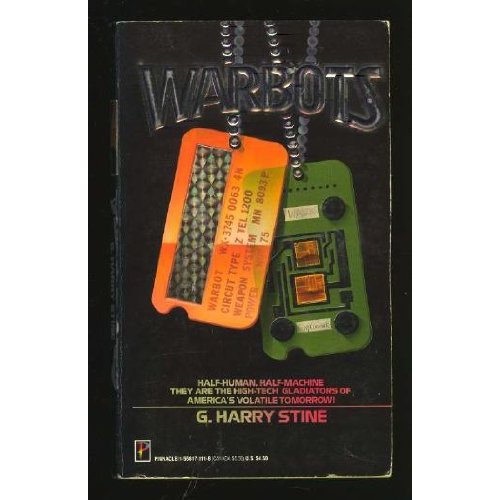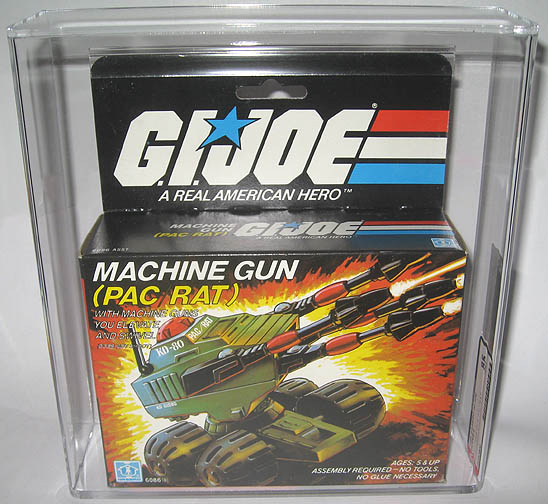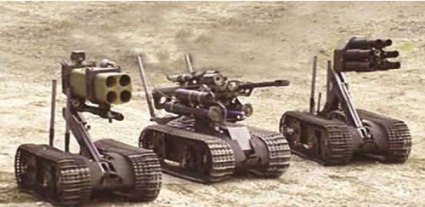
In the high-tech laboratories of tomorrow a new breed of super-soldier is born! The brutal face of warfare has been dramatically altered. Armored giants now roam the explosive fields of battle-massive instruments of devastation with computer minds inseparably linked with the brainwaves of their human masters. They are the Warbots, men and machines combined to create the most lethal warriors in the history of armed conflict. But a monstrous challenge emerges for the mechanical gladiators emanating from a country technology forgot. As Captain Curt Carson leads his robot infantry in a daring attempt to rescue 105 hostage Americans from the sadistic clutches of a bloodthirsty terrorist army, the soldiers of tomorrow face the butchers of yesterday in a battle for the future of the free world! -Warbots Back Cover
As I read more and more about the US becoming a country focussed on Drone Warfare, the Warbots series by G. Harry Stine begins to look more and more prophetic.
I originally picked the books up back in the 80’s at City Lights used bookshop because I was a huge mecha fan, and saw their covers:
Of course, I don’t think the guy who did those covers ever actually read the books, or maybe the publisher was looking for something more metaphorical, because that’s not what the Warbots in the story look like at all. They actually look more like this:
That’s a P.A.C./R.A.T. from the 80’s G.I. Joe toy line, and the set of them actually represent the Warbots in the book so well that I’ve often wondered if they aren’t a tribute of sorts to the books. Like the R.A.T.S. the Warbots aren’t very big, being about the size of a golf cart, and each one is equipped with a specialized weapon for a particular function. In the book, each type has a nickname, usually based on their weapon characteristics. The one I remember is the “Saucy Cans”, which is the nickname for the Soixante-quinze (75) Millimetre guns they were using.
So basically the Warbots books are military Sci-Fi books about squad-level combat in a future where the US Army has heavily integrated drone units into their forces. If I recall right (it’s been a while since I read them) a squad now consists of a human commander, and a team of AI Warbots under his or her command. The AI’s in the story aren’t very smart, and basically just follow orders (they operate on the level of a Starcraft unit), but they are incredibly deadly and dangerous, especially when properly arrayed.
The humans in the unit are all using neural interfaces that let them communicate with each other instantly using surface thoughts, and they can control and communicate with the bots using this system. It makes them quite a terrifying force in the field, actually, because the Warbots are acting as extensions of the human soldiers, albeit slightly dumb extensions that often require the humans to be on-site to supervise. (The human side of the stories don’t take place in an air conditioned military base in Nevada like real drone war combat might.)
As I recall, the stories usually tend to be about the unit in the story trying to accomplish missions in the third world. A lot of it is about them trying to deploy their Warbots to deal with overwhelming enemy forces that the bots can only hold off for so long. The Warbots aren’t very nimble (no ninja-stealth-robots here) since they’re mostly small tracked vehicles, and as a result in urban and jungle terrains can really be quite limited by the environment.
In terms of writing, the stories are okay. They’re really pulp adventure novels in a lot of ways, but with a very cool concept behind them that was way ahead of its time. Our hero Captain Curt Carson (square jawed, heroic military commander) leads his team of tough but lovable troopers on a series of missions that has him fighting villainous dictators and romancing princesses across the globe. (Not kidding, the love interest that shows up later in the series is the daughter of the Sultan of Brunei.)
Despite this, I actually recommend giving them a look if you’re into military sci-fi or the future of combat in general. While dated in some ways, I do think that Stine had the right ideas, and that in twenty years the future of warfare will look a lot more like his novels than it will how we fight today.



